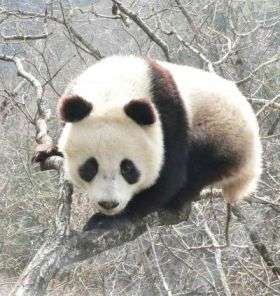December 7, 2010 report
Plan to reintroduce giant pandas to the wild

(PhysOrg.com) -- Scientists in China have been so successful at breeding giant pandas in captivity that they are now planning for their reintroduction to the wild with 15 years.
The giant panda, which is classified as an endangered species, is a difficult animal to breed in captivity because the females are on heat for only 72 hours a year, and there is only a 12-24 hour window in which they can become pregnant. Another difficulty is that the males have short penises and the mating couple must adopt an exact position if the mating is to be successful, and yet the pandas in captivity appear to have little knowledge of this position.
Scientists at the world’s most successful panda breeding center, the Chengdu Panda Breeding Research Centre in China have been trying to breed captive pandas for decades and have overcome many obstacles, including the short period of fertility, which necessitates them taking daily urine samples to monitor hormone levels, and close observation of panda behavior.
Another challenge facing conservationists is that pandas are "turned off" by being in captivity and do not seem interested in mating. The Chengdu researchers have tried arousing male pandas by using bamboo poles laced with the scent of fertile females, but few encounters were fruitful and some ended in aggressive behavior and violence. The scientists also tried Viagra and resorted to showing sex education videos to the captive bears, both with little success.
The scientists then tried artificial insemination, but this was also a challenge because of the variation in gestation, which can last anywhere from 11 weeks to 11 months, and which can be undetectable until shortly before the birth. Again, the scientists needed to closely observe the bears, and they developed a crucial form of intervention to ensure the survival of cubs, which was necessary since pandas give birth to twin cubs around 50 percent of the time, but they usually only care for one of them.
The intervention is called a "twin-swapping" technique, in which an abandoned cub is immediately moved into an incubator. The scientists then surreptitiously rotate the twin cubs between mother and incubator to trick the mother into caring for both of them. Using this technique the survival rate has risen to 98 percent. By the end of 2009, 168 cubs had been raised at the center.
The success of the breeding program has led conservationists to believe it will be possible to reintroduce giant pandas into the wild, and they have used some of the profits made from lending their pandas to overseas zoos to buy panda habitat in the Sichuan mountains in south west China and to begin construction of the first dedicated giant panda reintroduction facility.
© 2010 PhysOrg.com



















